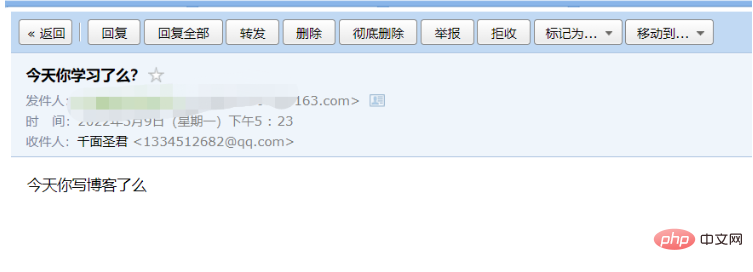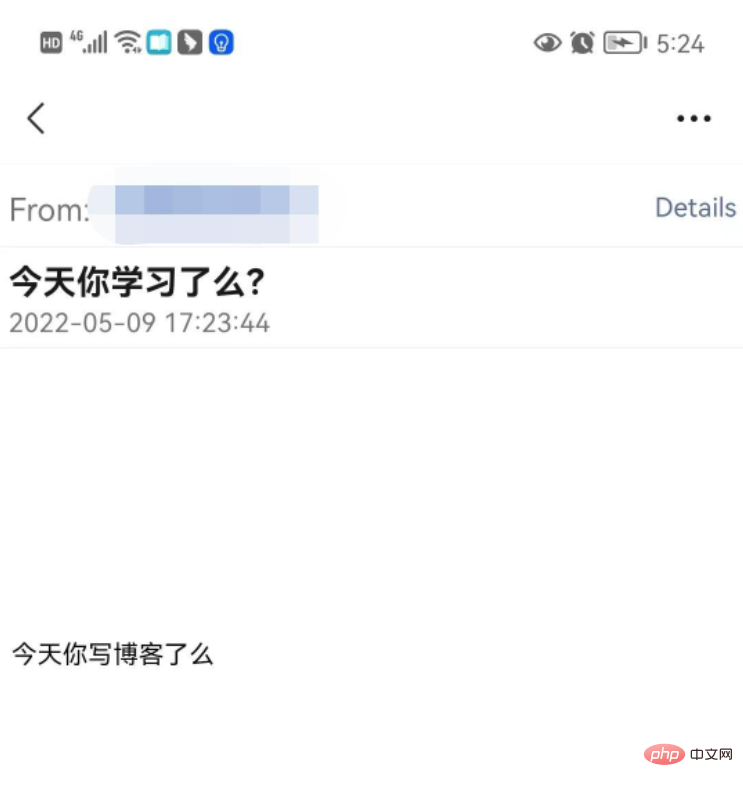Heim >Java >javaLernprogramm >Wie implementiert man eine einfache Massen-E-Mail-Funktion auf Java-Basis?
Wie implementiert man eine einfache Massen-E-Mail-Funktion auf Java-Basis?
- 王林nach vorne
- 2023-04-20 16:28:082157Durchsuche
Die POM-Datei führt Abhängigkeiten von Drittanbietern ein
<dependency> <groupId>javax.mail</groupId> <artifactId>mail</artifactId> <version>1.4</version> </dependency> <!--lombok--> <dependency> <groupId>org.projectlombok</groupId> <artifactId>lombok</artifactId> <optional>true</optional> </dependency>
Der Java-Code lautet wie folgt
import lombok.Data;
import javax.mail.Message.RecipientType;
import javax.mail.MessagingException;
import javax.mail.Session;
import javax.mail.Transport;
import javax.mail.internet.InternetAddress;
import javax.mail.internet.MimeMessage;
import java.io.IOException;
import java.io.InputStream;
import java.util.ArrayList;
import java.util.List;
import java.util.Properties;
/**
* Created by tarzan liu on 2021/5/9.
*/
public abstract class EmailUtil {
private static final Session session;
private static final EmailAuthenticator authenticator;
static {
InputStream inputStream = null;
try {
inputStream = EmailUtil.class.getResourceAsStream("/email.properties");
Properties properties = new Properties();
properties.load(inputStream);
authenticator = new EmailAuthenticator();
String username = properties.getProperty("email.username");
authenticator.setUsername(username);
String password = properties.getProperty("email.password");
authenticator.setPassword(password);
String smtpHostName = "smtp." + username.split("@")[1];
properties.put("mail.smtp.auth", "true");
properties.put("mail.smtp.host", smtpHostName);
session = Session.getInstance(properties, authenticator);
} catch (Exception e) {
throw new RuntimeException("init error.");
} finally {
if (inputStream != null) {
try {
inputStream.close();
} catch (IOException e) {
e.printStackTrace();
}
}
}
}
private EmailUtil() { }
/**
* 群发邮件方法
*/
private static void massSend(List<String> recipients, SimpleEmail email) throws MessagingException {
MimeMessage message = new MimeMessage(session);
message.setFrom(new InternetAddress(authenticator.getUsername()));
InternetAddress[] addresses = new InternetAddress[recipients.size()];
for (int index = 0; index < recipients.size(); index ++) {
addresses[index] = new InternetAddress(recipients.get(index));
}
message.setRecipients(RecipientType.TO, addresses);
message.setSubject(email.getSubject());
message.setContent(email.getContent(), "text/html;charset=utf-8");
Transport.send(message);
}
/**
* 发送邮件
*/
public static void send(String recipient, SimpleEmail email) throws MessagingException {
List<String> recipients = new ArrayList<>();
recipients.add(recipient);
massSend(recipients, email);
}
//可以单独建一个类
@Data
public static class SimpleEmail {
private String subject;
private String content;
}
public static void main(String[] args) throws Exception {
SimpleEmail simpleEmail = new SimpleEmail();
simpleEmail.setSubject("今天你学习了么?");
simpleEmail.setContent("今天你写博客了么");
send("1334512682@qq.com", simpleEmail);
}
}email.properties System-E-Mail-Konfiguration
email.username=###@163.com
email.password=###
Ihre E-Mail-Adresse Für Konto und Passwort können Sie die Konfigurationsdatei auch weglassen und Konto und Passwort direkt in den Code schreiben.
Führen Sie den Test aus
Klicken Sie mit der rechten Maustaste auf „Ausführen“, um die Hauptmethode auszuführen.


Verknüpfen Sie die sendende E-Mail-Adresse mit WeChat und nutzen Sie die WeChat-Erinnerungsfunktion!

Das obige ist der detaillierte Inhalt vonWie implementiert man eine einfache Massen-E-Mail-Funktion auf Java-Basis?. Für weitere Informationen folgen Sie bitte anderen verwandten Artikeln auf der PHP chinesischen Website!
In Verbindung stehende Artikel
Mehr sehen- Wie fügt man im Frühjahr Abhängigkeiten in selbstinstanziierte Objekte ein?
- Wo sollten Sie Ihre JFrames platzieren?
- Implizite vs. explizite Wartezeiten in Selenium-WebDriver: Was sollten Sie wählen?
- Wie füge ich zur Laufzeit dynamisch Dateien zum Java-Klassenpfad hinzu?
- API-Debugging: Best Practices zum Abrufen von Testdaten aus einer Datenbank

